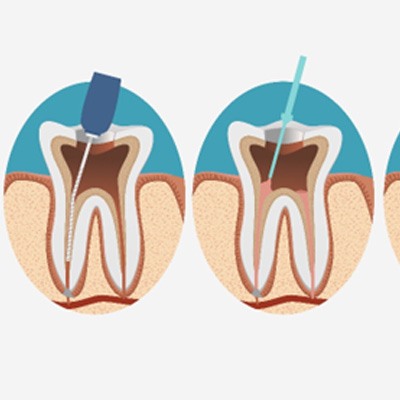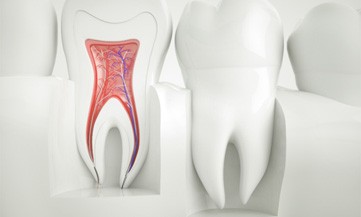Root Canal Treatment – Chesapeake, VA
Soothe Tooth Pain with Root Canal Treatment

Does drinking iced tea or hot coffee have you agonizing in pain? Maybe one of your teeth has simply been hurting constantly for a while now. In either case, it would seem you are dealing with an infection inside the dental pulp – the bundle of nerve endings located at the center of your tooth. Since this area is so sensitive, it can cause discomfort to the degree that it interferes with your daily life. Hope is not lost, however, because here at Troisi Dentistry we want nothing more than to soothe your tooth pain with root canal treatment at our Chesapeake, VA dental office to give you a reason to smile once again. Contact us so Dr. Troisi can get you back on track with root canal therapy in Chesapeake!
Why Choose Troisi Dentistry For Root Canal Treatment?
- Same-Day Emergency Appointments
- Proudly Welcome Dental Insurance
- Nitrous Oxide Sedation For Comfort
Do I Need Root Canal Treatment?

The most common indication of the need for a root canal is a severe, persistent toothache. However, that is certainly not the only symptom to look for. Other signs you might need a root canal include:
- Extreme, prolonged sensitivity to hot or cold foods or beverages
- Sharp pain when biting down
- Dark discoloration of a tooth
- Swelling or redness of the gums surrounding a tooth
- A pimple-like bump on the gums near a tooth
As soon as you notice any of these symptoms, contact our team. We’ll get you in for an appointment ASAP.
The Root Canal Treatment Process

The term “root canal” gets a bad rap, but this procedure is actually painless. In fact, by removing the infected nerve of the tooth, a root canal is designed to relieve pain. Plus, your restorative dentist in Chesapeake will numb your mouth with a local anesthetic beforehand so you will remain comfortable throughout the process.
We will begin by using special instruments to access the inner chambers of the tooth and remove the pulp that’s triggering your pain. After sanitizing the area, we’ll refill it with a synthetic gutta-percha material to retain the tooth’s shape. The next step is to seal and protect the tooth by placing a temporary dental crown. As your mouth heals, the area around the tooth might feel a bit sore and tender.
A few weeks later, we will see you at our dental office. Then, we’ll switch out your temporary crown for a permanent one. At that point, the underlying tooth should be fully protected. You’ll be able to use it as you normally would – bring on that cup of coffee!
The Benefits of Getting a Root Canal

While replacement options like dental implants definitely have their benefits for your smile, preserving your natural tooth should always be the primary goal. If you hesitate to get a root canal when you need one, the infection might progress to the point of no return and your tooth will have to be extracted entirely. Removing and replacing a tooth is a much more complex, time-consuming, and wallet-draining venture than root canal therapy.
In addition to saving your natural tooth, root canal therapy has other benefits:
- Virtually pain-free procedure – Thanks to the advanced dental technology we use, getting a root canal is about as comfortable as the process for an ordinary filling.
- High success rate – The vast majority of root canal patients retain their treated tooth for decades, if not the rest of their lives.
- Aesthetically pleasing results – After your root canal, your tooth will be restored with a custom-made dental crown that seamlessly blends in with the rest of your smile.
Understanding the Cost of Root Canals

Even after learning about how little discomfort is associated with root canal therapy, there’s still one aspect of the treatment that some patients may remain concerned about: the cost. There isn’t a set price for root canals, but we can go over the relevant factors with you so that you have an idea of what you’ll need to pay. Naturally, we want you to be able to fit root canal therapy into your budget with as little trouble as possible, so we’ll also walk you through the available payment options.
Factors That Can Affect Root Canal Cost

Some root canal treatments involve higher fees than others. Contributing factors include:
- The specific tooth that needs to be treated. Molars are usually more costly to treat than other teeth since their more complicated anatomy often calls for a more extensive root canal process.
- How complex the case is. You may be referred to another practice for any issues that require a specialist’s touch.
- Any services that are performed in addition to the root canal. Most of the time, this will include a dental crown for protecting the tooth that received treatment.
Is it Cheaper to Pull My Tooth?

If you’re simply talking about the costs of the two procedures by themselves, then yes, a tooth extraction will usually have a lower price than root canal therapy. But when it comes to the long-term, cumulative costs, then the answer is more complicated. Having a tooth removed often means having to pay for a costly replacement. And if you choose not to have the tooth replaced, you’ll be at a greater risk of bone loss, bite misalignment, and other oral health issues.
With root canal therapy, you generally only have to worry about paying for one procedure. This means that a root canal can ultimately be the financially smarter choice in many circumstances.
Does Dental Insurance Cover Root Canal Therapy?

You should never make any assumptions when dental insurance is involved; always talk to your insurance provider to clarify the details of your coverage. Our team can also double-check your plan and explain your benefits in clearer detail.
Most insurance plans do include partial coverage for root canal therapy. Some plans will pay as little as 40% of the total price while others might cover as much as 80%. It generally depends on whether your insurance company thinks of root canal therapy as a major procedure or a minor one.
Other Options for Making Root Canal Therapy Affordable

At Troisi Dentistry, patients without insurance can still enjoy lower rates for important dental work by signing up for our in-house membership plan. Also, if you’re not sure that you’ll be able to pay the entire cost of your treatment all at once, CareCredit financing can help you ease that particular burden with a suitable payment plan.
Root Canal FAQs

Since root canals continue to be one of the most feared procedures (even though they are more efficient, fast, and painless than ever), it’s very normal to have questions for our Chesapeake dental team before your treatment. At your initial appointment, as well as each one after, we will answer any questions you have and do our best to address your concerns. Of course, if you want to learn more about this tooth-saving treatment in the meantime, you can do so by simply reading on!
Are Root Canals Painful?
Good news: root canal treatment isn’t painful thanks to powerful and effective local anesthetics. Before removing the pulp of your tooth, we will thoroughly numb the area so you don’t feel anything more than some slight pressure from our team working. Plus, we offer sedation dentistry for patients who are particularly anxious or struggle with more severe dental sensitivity. Simply put, we will do everything we can to make your time in the treatment chair as comfortable and pain-free as possible.
Can Root Canals Be Prevented?
In large part, yes! To prevent tooth decay, you should implement a solid at-home oral hygiene routine, which includes brushing twice a day, flossing daily, and rinsing with mouthwash each evening. You should also take proactive measures like not smoking, keeping your consumption of added sugar to a minimum, and visiting us every six months for a checkup and cleaning. This last point is particularly important since periodic appointments with our team will ensure that any oral health concerns, like cavities, are caught in the early stages.
Can I Take Antibiotics Instead of Getting a Root Canal?
No, antibiotics are not a replacement for root canal therapy. That’s because antibiotics cannot reach the pulp of your tooth, and therefore won’t work on tooth infections. The only way to restore the health of your smile as well as the look and function of your tooth is by getting professional dental care.
What Happens If You Wait Too Long for a Root Canal?
Simply put, the longer you wait, the more time the infection has to progress. If we intervene with a root canal now, then we can stop the damage in its tracks and restore your oral health. If we don’t, then your oral health will suffer to the point where eventually the tooth needs to be extracted. So, don’t wait. When we recommend a root canal, schedule an appointment as soon as possible – it’s the best choice for your smile and wallet!
What Should I Do Before a Root Canal?
Leading up to your appointment, our team will provide you with any specific instructions necessary. For example, if you are getting nitrous oxide, we may recommend arriving a few minutes early so we can help you relax before getting started on your treatment. Across the board, however, there are a few things we recommend, such as getting a good night’s sleep before your appointment and continuing to implement a solid oral hygiene regimen.
I Need a Checkup & Cleaning I Need a Dentist for My Child I am Concerned About Bleeding Gums I Have a Cavity or Broken Tooth I am Missing One or More Teeth I Want to Enhance My Smile I Want a Straighter Smile I am Scared of the Dentist I am in Pain & Need Help I Need My Wisdom Teeth Removed I Have Pain in My Jaw View Our Services
